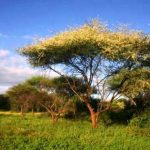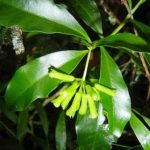TREE LIFE
December 2002
A WISH FOR ALL OUR MEMBERS.
HAVE A VERY HAPPY CHRISTMAS AND MAY THE NEW YEAR BRING PEACE.
AS BEFORE PLEASE CONFIRM WITH ANY OF THE COMMITTEE MEMBERS THAT THE SCHEDULED OUTINGS AND WALKS WILL ACTUALLY TAKE PLACE. SEE THE BACK PAGE FOR PHONE NUMBERS.
MASHONALAND CALENDAR
Tuesday 10th December: Botanic Garden Walk. Meet Tom in the car park at 4.45 p.m. for 5 p.m. for the continuation of the family Leguminosae.
PLEASE NOTE THE CHANGE OF DATE. Many members will be away viewing the eclipse near Beit Bridge.
Sunday 15th December: There has been a change of venue for our Christmas walk and social. It will now take place at Ewanrigg Aloe Garden on the Enterprise Road. This year, for a change, we will have a ‘bring and share’ luncheon after a walk in the gardens which so impressed us on our last visit to Ewanrigg. Please bring your own meat and a salad or a pudding to share. The committee members will provide tea and/or coffee as well as the wine with the meal but there will be no objection if you wish to supplement rations and bring a bottle as well. Please also bring a chair and a fold up table if you have one and whatever else you will need in the way of crockery and cutlery as well as your wine glass and tea cup. We are happy to report that Tom Muller will be joining us.
Saturday 4th January: Mark’s Walk will be at Domboshawa. Take the Borrowdale road out of Harare and continue for 33 km s and turn right to Domboshawa Caves. We will meet in the car park at 2.30 p.m. N.B The Entrance fee may be in the region of $100.
Tuesday 7th January: Botanic Garden Walk.
MATABELELAND CALENDAR
The traditional New Year’s social will take place at 9 Barton Grange, off Oxford Road. For further details, please phone Joy Ketts.
EASTERN HIGHLANDS TEA ESTATE TRIP, SEPTEMBER 27TH – OCTOBER 1ST
Each day we wound our way around round green hills, covered with plantations of tea, Camellia sinensis, but unfortunately the spectacular views were all hidden in haze throughout our stay at the Eastern Highlands Tea Estate.
Friday
n that first morning there were nine of us and our destination was the Nyamingura River with its associated riverine vegetation. We followed Tom, shirtless and armed with a panga and a large plastic bag, down a path through a strip of riverine forest. Maranthes goetzeniana, Newtonia buchananii and Macaranga capensis were the big canopy trees with Harungana madagascariensis and Trema orientalis in the lower canopy, all an indication that this was very much regenerating forest because those are all pioneer species. To Tom it was a bit disappointing because the forest was not mature, to the rest of us it was lovely because we were in forest with a canopy of trees which were well above us and all around were trees not seen very often, both old friends and new.
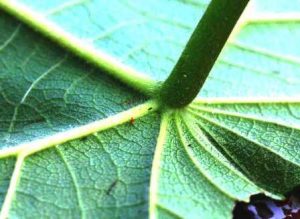
Macaranga capensis. Photo: Bart Wursten. Source: Flora of Zimbabwe
With peltate leaves, (the petiole joining the leaf on the undersurface instead of at the edge, like a nasturtium leaf) Macaranga capensis, River Macaranga, was unmistakable. This is a riverine species occurring at low altitudes. Surprisingly, later we also saw Macaranga mellifera, Mountain Macaranga, which is usually associated with cooler climates at higher altitudes, but sometimes seems to have crept down along the rivers to lower altitudes. Although distinctly 3-veined from the base, the leaves of the River Macaranga have 6-14 pairs of lateral veins, whereas those of the Mountain Macaranga have only 6 or 7 pairs and are not nearly so conspicuously peltate, although they are sometimes slightly so. Something Mark showed me later on in the trip is that the undersurface of the leaves of both species is covered with little golden glands visible with a 10x lens. I am not sure if they can be seen with the naked eye.
Maranthes goetzeniana belongs to the family, Chrysobalanaceae, the same one as the familiar Mobola-plum, Parinari curatellifolia, but there the resemblance appears to end. Maranthes has large leaves with a very pronounced drip tip. Many forest trees have large shiny green leaves, all about the same size and with a drip tip, probably, because firstly, they need as much leaf surface as possible to catch the light and secondly they cannot afford to have water lying on them and this is one way of making sure the water runs away. This similarity of leaves can lead to problems of identification – when one can reach the leaves, of course. But Maranthes does have some labels telling us what its name is. Apart from the leaf apex, which is very conspicuously drawn into a point about 2 cm long, there are two little glands at the junction of the midrib and the petiole and the stipules on the new growth have brown teeth around the upper half. Later we looked at the outline of the tree. This is a widely branching tree and each branch has its own crown of leaves, presenting a jagged outline over the top.
Newtonia buchananii, Forest Newtonia, a tree of wet evergreen forest, copes with excess water in a very different way, by having leaves rather like a sieve. The leaves are bipinnate, like Acacia leaves, with many pairs of pinnae, each bearing many pairs of tiny leaflets. The label for these trees is that the leaves have little glands, rather like a bee’s sting on the rachis between the pairs of pinnae and the pods open only along one side and so fold out flat. Although considered a pioneer species, it is also found in climax forest and the trunk is often buttressed, but the buttresses are not regular, there usually being one larger than all the others.
Bridelia micrantha and Erythroxylum emarginatum are both species that we are more familiar with away from forest, although I think they are often riverine. Bridelia micrantha is always recognisable with the lateral veins running right to the margin of the leaves, and on this occasion was conspicuous with new young red leaves. And, of course, we always recognise Erythroxylum emarginatum by the ‘lizards’ legs’. We just have to remember to look for them!
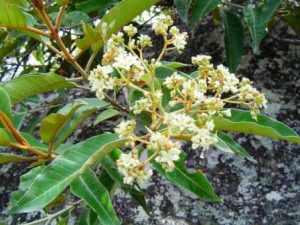
Harungana madagascariensis. Photo: Bart Wursten. Source: Flora of Zimbabwe
Anthocleista grandiflora, Forest Big-leaf, Polyscias fulva, Parasol-tree and Harungana madagascariensis, Orange-blood or Praying-hands, are all also considered to be pioneers and are all very distinctive. Anthocleista grandiflora has very large leaves, usually 70 x 25 cm but can reach 150 x 50 cm, one of the largest simple leaves in the tree world in Zimbabwe. These coppice freely and grow easily from seed and there are a number growing in Harare, often visible high above a garden wall.
The Parasol Tree, Polyscias fulva, has pinnate leaves, all densely velvety with creamy rusty hairs on the undersurface, looking like a two-tone leaf. It has a tall straight trunk and only branches fairly high up. This belongs to the family Araliaceae, the same family as the cabbage trees, Cussonia. C. A. Smith tells a nice little story about the common names of these trees. The Afrikaans name for the Cussonia is kiepersol, which is actually a corruption of the Portuguese name “quita sol” meaning “excluding the sun,” which was coined by Indians as “kitty sol” or “kippe solis”, to describe a type of light bamboo and paper parasol.
I expressed delight at seeing Harungana madagascariensis, and called it Orange-blood or Praying Hands. These trees are one of the earliest colonisers and with their distinctive yellowish brown appearance are often seen at the edge of clearings as small, lookable at and reachable. One is able to see the young leaves at the ends of the branchlets tightly pressed together like praying hands, or pick a leaf and see the orange sap. Obviously Tom decided that this was nonsense and a good opportunity for a bit of leg pulling and said that really they were just rubbish trees and for the rest of the visit wherever we saw them delighted in mentioning the fact.
Rutidea fuscescens, Single-tail Rutidea, one of the smaller species, described as a shrub or liana, 1-9 m high, is something I am starting to recognise. I think that it is always very hairy and the growing tip with its mass of single-tailed stipules is distinctive. The other species Rutidea orientalis, has stipules with a fringe of 3-15 very fine tails. Keetia gueinzii, Climbing Keetia, is another scrambling shrub that is quite widespread, occurring at the margins of and in evergreen forest. This has branchlets that bend backwards to help it latch on to other plants and although most of the leaves are oblong-lanceolate, in other words quite long compared to the width, the leaves that subtend the lateral branchlets are much smaller and almost round. I am discovering that different shaped or sized leaves is quite often a feature of Rubiaceae, the family to which these two genera belong. Tarenna pavettoides, Large-leaved Tarenna, also in the understorey, often has at one leaf in a pair much smaller than the other on most of the branchlets.
Below knee height was a patch of wild ginger, Aframomum, with both narrow leaves and broad leaves, which Tom thought had recently been split into two species. The one with narrow leaves is obviously the original Aframomum angustifolium, also known as Madagascar cardamom. Abassi of BirdLife, who had joined us for the day and was very knowledgeable on the plants, said that the leaves, stems and fruits were all edible and some of us tried chewing a leaf. But although some of us definitely found them spicy, Gill said she couldn’t taste anything, which was not surprising, as she had picked the wrong thing and was chewing a piece of broad-leaved grass. I gathered that the roots are rather fibrous and not nice and juicy, unlike those of the commercial ginger of the genus Zingiber. Aframomum does belong to the ginger family Zingiberaceae, known as the ginger, cardamom and turmeric family, and described as a distinctive family of perennial aromatic plants. They all have branched underground fleshy rhizomes. The leaves, which emerge from the rhizomes as two distinct ranks, are fairly large with closely parallel pinnate veins diverging obliquely from the midrib. True cardamom, Elettaria cardamomum is grown on the Estate and Sue brought some seeds along which we added to our tea, which she had also kindly provided. I enjoyed it.
Our path ran out into very degraded forest and then into tea plantation, so we retraced our steps, but before moving on had a look around the bridge next to which we had parked. From the branches of a Breonadia, growing in the rocks on the edge of the river was a very substantial rope, which I recorded as Strychnos lucens. There were some green fruits on the ground, which had been eaten probably by Samango monkeys. During that weekend we also saw Strychnos angolensis, another very substantial rope with a woody stem at least 15 cm in diameter and which Tom described as very rare. One of the apparent differences between them is that Strychnos lucens has paired tendrils and Strychnos angolensis has single tendrils borne in the axils of triangular bracts. When fruit are available, Strychnos angolensis has fruit with only one seed and Strychnos lucens has fruit with a hard shell and 10-30 seeds. Although I did not know to look for tendrils at the time, in retrospect, from the fruit we saw, I think that must also have been Strychnos angolensis.
Tom then spotted a tree and rushed down to slash it and show us ‘cherry-red lips’ just like his sister-in-laws’. Unfortunately, the bark he slashed did not produce ‘cherry-red lips’ at all, which was not really surprising as there were two trunks growing close together and he had slashed the trunk of Englerophytum magalismontanum, Stem-fruit. The trunk that did produce cherry-red lips when slashed proved to be Cleistanthus polystachyus, Forest Umthithi. The branches are described as long slender and drooping and towards the end one of them was a flower which I was able to reach and photograph. Another species in flower was a Eugenia. This I collected and took to Braam van Wyk to identify. He pronounced it to be Eugenia natalitia, Forest Eugenia, because the flowers were on the previous year’s growth whereas the other, unlikely, possibility, Eugenia woodii, bears flowers on the new growth.
I have always had a bit of a mental block between Oxyanthus and Psychotria. When bearing flowers or fruits the differences are obvious because Psychotria bears them at the ends of the branchlets and Oxyanthus bears them in the leaf axils, with one per node on opposite sides of alternate nodes. And in the absence of flowers or fruits, as is so often the case, there is a problem. On that first day we certainly saw Oxyanthus speciosus, Whip-stick Tree, Psychotria mahonii, Large Bird-berry and Psychotria zombamontana, Red-fruit Bird-berry. I think the leaves of Oxyanthus speciosus are three to four times longer than wide, have a very pronounced drip tip and at least some of the leaves have a slightly asymmetric base, and are usually all on the same plane. The leaves of Psychotria are decussate, (opposite and one pair at right angles to the next). Psychotria mahonii has leaves with 7-10 pairs of main lateral veins and the leaves of Psychotria zombamontana have more, 10-16 pairs. So those are easy to distinguish between. Psychotria mahonii is a species of lower altitudes and Psychotria zombamontana occurs at higher, cooler altitudes, except when it sneaks down rivers as it had done here.
We moved on to another spot next to another bridge on the same river. There was no doubt about the identification of the fig, Ficus craterostoma, growing on the bridge. This should be called the blunt-leaved fig the leaf apex is so truncate or flat, at times almost curving inwards. Another member of the fig family Moraceae we saw was Trilepisium madagascariense, Urn-fig. It has a long slender leaf with a long slender apex and a milky sap. Also with a milky sap, but this time a member of Apocynaceae, was Landolphia kirkii, a liana with tendrils and a big thick trunk with longitudinally rippled bark. Jackie tried the ‘chewing gum’ which she said was much nicer than ordinary chewing gum and it made a noise as she chewed it. It was the gum that made the noise, it was not a people chewing noise. Mussaenda arcuata is said to have a milky or watery sap but when I tried it the leaf appeared to have rubbery threads when gently pulled apart, rather like Maytenus acuminata, Silky-bark, which was also there. That has pink stems and petioles. Tom mentioned that it is not often seen in our forests. It is quite widespread in South Africa.
Tom also mentioned that Aidia micrantha is the commonest understorey in forests at lower altitudes. We saw this frequently and I still don’t really have a picture of it. The leaves are characteristic of forest leaves, shiny green, but they do have a very wavy margin. However, it does present its flowers in a fairly unique way. Like all Rubiaceae the leaves are opposite, but when it flowers, these are borne opposite a normal leaf, the other being long thin and thread-like and fall early. I have made a note that in fruit they are distinctive and they certainly are as we discovered later. It looks as though the little bunch of fruit has replaced a leaf. The fruit are slightly wider than long and crowned with scar left by the calyx. Another note that I made later is that it has a white bark.
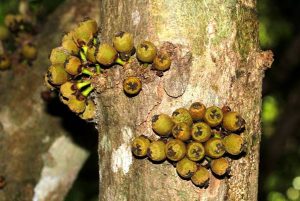
Drypetes natalensis. Photo: Bart Wursten. Source: Flora of Zimbabwe
We walked along a road more or less parallel to the riverine fringe, making little forays into the forest along interesting looking paths. One of these produced great excitement, Drypetes natalensis, Stem-fruit Iron-plum, in full flower. I borrowed Werner’s tripod, glued myself to my camera and did not see much else on that path. The flowers are borne on the trunk. From memory these flowers were full of stamens so it must have been a little boy tree. The leaves are large, dark shiny green but they do have a label, the margin is jaggedly toothed with the teeth almost spine-tipped, rather like a holly leaf and the base of at least some leaves is asymmetric.
When I eventually emerged, the party was well spread out along the road and Tom and Sue were seen disappearing into the distance on the other side of a tea plantation. They did that walk on their own. Tom was on a mission to find his rare fig. By this time, it was midday and no one else felt any desire to go out in the midday sun. We congregated around a bridge with the sound of the clear running water adding to the illusion of coolth. We spent the time speculating on the identity of the huge tree above us. There was green fruit on the ground and we were being dripped on. There was also speculation as to where the moisture was coming from; eventually the possible source being the bladder of a Samango monkey was ruled out. That tree proved to be Maranthes as we discovered when Tom returned.
After lunch we moved on to the Nywamba River. This involved quite a lot of driving around round green hills covered with tea, travelling more than we had intended to as our road was blocked by a tractor and trailer on a bridge, sideways, somewhat to the distress of the driver. This forest proved to be the culmination of highlights in a day filled with highlights. First we found Tom’s very rare fig, Ficus modesta. It looked such an easy matter to get a sample, as we looked as though we were more or less at the same height. But we were up on a steep bank and the tree was down on the river terrace. Abassi, by throwing sticks, managed to get a few leaves down. When we visited the site again on Monday we were able to obtain a better specimen, but that is another story.
The path to the waterfall took us through pockets of pristine forest. On the floor was the broad-leaved forest grass whose name I have always wanted to know, Olyra latifolia, with the characteristic parallel veins of the monocots. Garcinia kingaensis, Forest Mangosteen, has a yellow sap and leaves with fine parallel veins almost at right angles to the midrib. In places the bark had been removed so it obviously has a use. Around the pool at the bottom of the waterfall the forest was mainly Garcinia. But there was also Filicium decipiens, Fern-leaf. The names translate as ‘deceptively like a fern’ and the leaves certainly are very fern-like, being pinnate with a winged rachis, sometimes with a single leaflet at the end, sometimes with a pair of leaflets and sometimes with one of the pair twisting around and appearing imparipinnate, as often happens with Sapindaceae. This is a tree I know well from the Botanic Garden so seeing it in the wild was very exciting. Another tree that is fairly widespread, usually at higher altitudes, was Aphloia theiformis, Albino-berry. Embelia schimperi is a scandent shrub that climbs by means of hard persistent lateral branches and has very large leaves. These leaves with translucent streaks are supposed to be salty but I thought they had more of a lemon taste than a one of salt.
Tom mentioned having seen a Xylopia as we entered the forest at the beginning of the day, but this had proved to be something else and it was eventually not until right at the end of the day that we found Xylopia aethiopica, Many Red-fingers. Not that we had any chance of looking at the leaves. These were some 10 m above our heads and despite Tom insisting that it is always the ladies in the Tree Society who climb the trees, there were no volunteers, not even among the men. However, we were able to see the other characteristics. The branches, which were very high up, were horizontal and almost at right angles to the trunk, at the bottom of which were small buttresses not more than about one and a half metres high all the way around. We were shown the inevitable slash which was very hard and orange-yellow.
By then it was almost too dark to see any more and we were returned to our places of abode after a wonderful day well spent. Let me take this opportunity of saying a very big thank you to Tom for leading us in his own inimitable manner, to Sue for making all this possible, for her hospitality and transport, and to Maureen for sorting out the logistics of the trip. It was all great fun and I really enjoyed every minute.
-Meg Coates Palgrave
Some Remarks on Orchids
No doubt, our main field of interest on this excursion were rainforests. But orchids, ferns, etc. came into focus occasionally. They should be seen as important elements to study and understand succession in general, and I found this excursion very useful to learn a few practical lessons about age and durability of forests, which at the same time, are helpful for a better understanding of orchids and their ecology.
We saw, for example, some areas where the rainforest was regrowing and, therefore, was only 10-30 years old. These young forests were almost empty of epiphytic orchids and ferns. The bark was still ‘naked’ and not yet even colonized by lichens. These will arrive once the forest gets older, then mosses will eventually follow. This will allow humidity to become a more permanent feature, giving epiphytic ferns an opportunity to follow. The situation concerning orchid colonisation is more complex than for ferns because orchid seeds are like dust (much smaller than tobacco seeds); i.e. they consist only of an embryo and contain no endosperm. Subsequently, these seeds depend on ‘nursing aids’ which supply nutrients during the initial time after germination. These ‘nurses’ are small fungi growing in the bark or between lichens; they often establish very specialized relationships were a certain fungi species can help only a certain orchid species to germinate. Orchids, therefore, are one of the last floristic elements in the long line of succession and (except for some ‘generalizers’) are mostly found in mature rainforests. At the same time, these rules of succession help to explain the point that biodiversity levels are generally much higher in pristine forests than in some regrowth which may be only a few decades old. This reflects Tom’s concern to concentrate in our conservation efforts on these pristine forest patches.
Attempts to draw up a list of orchid species often failed because of the height and density of the canopy. Only at the Chitema River, the canopy was much easier to survey. Here, about 15 species were seen and identified. The list corresponds largely with the results from the previous excursion, published in Tree Life 232 of June 1999. One might expect a much higher species population from such high rainfall forests. Certainly true, G.C.K. Dunsterville reported in 1961 that he had found and identified 47 (!) orchid species on one single tree in a wet montane forest in Venezuela. This relative impoverishment in Africa is due to the aridity of the continent and includes the entire flora, not just orchids and other mesophytic elements.
Ground orchids, in particular, are even more poorly represented in the rainforest because the habitat is generally too wet and shady. However, there are always some exceptions to the rule, i.e. there are a few typical ‘rainforest specialists’ and we were able to find some healthy populations. At Aberfoyle Club, for example, we were shown Eulophia pulchra with large above ground pseudobulbs. This species has attractive yellow flowers with red markin.
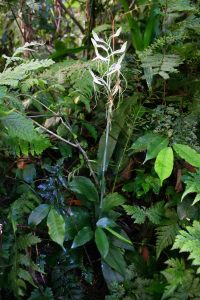
Habenaria macrandra. Photo: Bart Wursten. Source: Flora of Zimbabwe
At the Chitema River there were large populations of Cheirostylis nuda [syn. gymnochiloides] and Habenaria macrandra. (The latter has been misidentified in Tree Life 232 as Platylepis glandulosa). Cheirostylis nuda is a saprophytic species; it belongs to an evolutionary ancient genus and its flowers are only 2 mm in diameter. Many people would not consider this inconspicuous species to be an orchid. However, it was the first time I had seen this species in habitat in such large populations and therefore, was as pleased as Tom about his Newtonia-giants. Another rainforest species is Habenaria macrandra, one of the most unusual Habenaria species with an evergreen leaf rosette and fleshy hairy roots (instead of a tuber with deciduous leaves). The flowers are white and about 5 cm in diameter. Due to the prevailing drought (there has been no winter rainfall in this area this season), the latter 2 species were visibly under stress. All 3 species are evergreen, and this is an adaptation towards the wet habitat. In contrast, ground orchids on the highveld (with the exception of very few species) are deciduous due to the long and pronounced dry season.
Finally, a small example about changing vegetation and habitats: On our previous excursion to the Honde Valley during Easter 1999 we found a large Eulophia horsfallii – a colony of about 100 plants in the gum plantation next to the Club. Some plants even flowered and were really admired. Unfortunately, none of these plants do exist any longer because in the meantime, the gum plantation has been felled for commercial purposes.
-Werner Fibeck
Saturday
We stopped under a clump of trees dominated by Ficus rokko, previously part of the Ficus thonningii complex, a large strangler with many aerial roots that can reach the ground and form pillar roots, large stipules and fruit at the ends of the branches, and Myrianthus holstii, which must have had a 50 m high canopy. This has large, digitate, two-toned leaves that, when they fall, drape themselves on the surrounding vegetation. In the distance was Dracaena steudneri next to Ficus lutea with bronze stipules covering the stem buds and very large leaves usually longer than 12 cm, whereas Ficus rokko has leaves up to 12 cm long.
Tom must have got tired of saying Sapium ellipticum; we asked him “what is this?” so many times. And we should not have had to keep asking. It has a milky sap, the leaves have a toothed margin and at the base are two or four glands rather like those on the leaves of Croton. This species is a forest pioneer and so usually on the edge but it can become a canopy tree.
Combretum paniculatum, Forest Burning-bush, in red flower is just like the more familiar Combretum microphyllum, was in full view in the open, a surviving relic of a previous era when that area had been covered with rain forest. Very exciting to see were some cycads, Encephalartos manikensis, up on a granite dome and pretty inaccessible – we used binoculars to see them. We almost felt that we should not be showing too much interest in case someone was watching and realised that they had a value. Fortunately, that particular gomo does not have a name so I can avoid describing exactly where they were.
We then went down a long slope, all the time conscience of what goes down must come up again, but it was to prove well worth the trek. We saw Clutia abyssinica, Large Lightning-bush, which is supposed to have translucent gland dots in the leaves, but I don’t remember looking for those. This species has a distinct petiole. Another unusual tree was Blighia unijugata, which has a paripinnate leaf but usually with two or three pairs of leaflets and not ‘with one pair of leaflets’ as the name suggests. This coppices easily and germinates readily from seed, indicating that it is possibly a pioneer species.
The leaves of Uvaria lucida [previously Uvaria virens] had a distinct blue-green bloom on the undersurface and my notes say rather like Cryptocarya transvaalensis, which we also saw on the walk. Looking at the leaves of Cryptocarya transvaalensis with a lens, they have a very fine net-veining visible and ridged on both surfaces, almost as though the net-veining had been stuck on. Uvaria lucida also tends to have the same ridged net-veining but it has a much more open weave.
Eventually we reached the Chiteme River and were glad of a little break, but not for long’ there was so much to explore and that proved to be a very exciting spot. A rare Rubiaceae creeper Tom called Canthium henriquesianum but is now known under the name of Psydrax kraussioides. Tricalysia coriacea, [previously Tricalysia nyassae], Crown-fruit Jackal-coffee, Tom described as very rare and said he had previously only known of it from the Haroni. It is interesting that it was here as well, as was the presence of Maytenus chasei, another rare tree which has previously only been recorded from the Vumba. There was no doubt about the identification because it was in fruit and these are strange little 3-lobed capsules up to 10 mm in diameter with a wrinkled coating of small projections and they remain green even when mature. We saw a Syzygium, probably Syzygium guineense subsp. afromontanum and Tom wondered if it might be Syzygium owariense, a very rare species, also previously not known from that area, but in the end we decided that it wasn’t.
Drypetes gerrardii, Forest Iron-plum, which differs from the other species of Drypetes in that it has dense golden hairs on the young stems, the petiole and at the base of the leaves, which were only slightly asymmetric. Alchornea hirtella, Forest Bead-string was in fruit. It is an understorey tree with the large leaves crowded at the ends of the branches. The petiole is supposed to be swollen at both ends. On the dried specimens I have the petiole looks very thick and some of the leaves are at an odd angle, so perhaps that is more obvious on fresh material.
There was a lot excitement as Tom and Mary thought that a tree fern in the rocks on the side of the river was Cyathea thomsonii, the rarest of all the tree ferns in Zimbabwe. By this time, we had acquired an audience of children, who were amusing themselves watching us with an occasional break for a swim and, as with the cycads, we did not want to be seen taking too much interest. However, Mary had managed to collect a piece earlier and on quiet examination and reflection later decided it was Cyathea manniana, Spiny Tree Fern, after all.
It was a long way back again, some of us slower ones taking over two hours to get back to the vehicles, but I, for one, certainly felt it had been worth all the effort.
-Meg Coates Palgrave
Foliage Tourism
I am aware of wildlife, cultural and recently solar tourism, but was fascinated to learn that the autumnal hues of Wisconsin adds more than a billion USD in tourism revenue from “foliage touring” to their coffers annually. Is August/September Nyanga’s most lucrative month? Since my earliest days in the Tree Society the reason behind the red colouration of the early Msasa flush has been a point of discussion. Last year a mysterious second flush was noted and reported in Tree Life. According to the October 12th edition of The Economist, scientists are trying and better understand the reasons for leaf reddening and the environmental cues that stimulate it, to enhance their chances of marketing this pleasing natural spectacle for profit. In the temperate zones of the earth autumnal reds appear more prevalent, whereas in the tropics, spring is the season when plants masquerade a youthful blush of reds and there is no finer example than a Msasa woodland. A rock-hugging Ficus ingens in spring, a Duiker berry (Pseudolachnostylis maprouneifolia) or a Fire bush (Hymenodictyon floribundum) in autumn are solitary examples of this same phenomena in Zimbabwean botanical circles.
The pigments responsible for the red colour in spring and autumn are called anthocyanins and are active manufactured in the leaf, rather than revealed by the absence of chlorophyll. “In deciduous woodlands” according to the science and technology article in The Economist, “the first signs of approaching autumn are written across the forest in shades of yellow and orange. Lower temperatures and shorter days trigger the breakdown of chlorophyll – the green molecule that captures energy from light in the process of photosynthesis. As the chlorophyll is removed, it reveals other pigments that have been swamped by its bold colour. These are called carotenoids. They give rise to pale and brilliant yellows, ambers, golds and oranges. Different species of tree retain different amounts of carotenoids, which leads to much of the polychromatic beauty of a forest in autumn”.
Anthocyanins, act as sun blockers to protect the photosynthetic apparatus of the leaf from excessive light. As a plant starts to dissemble its light gathering apparatus, chlorophyll, for relocation from leaf to stem or root system in preparation of winter, its leaves become particularly sensitive to light damage. Were anthocyanins not available, the action of light on partially dismantled chlorophyll would produce free radicals and peroxides that would kill the leaf. (these two products also kill tissues in the human body). However, the leaf is in the process of being discarded so why the fuss about killing a leaf? The plants survival strategy is to dissemble the chlorophyll molecule and store the individual building blocks of chlorophyll outside of the leaf. In this way the essential building blocks for next year’s leaf flush are available and just require reassembling. If free radicals were to abound in the leaf, then premature leaf loss would result in loss of essential components and threaten the very existence of the tree. Anthocyanins have been shown to be more prevalent in leaves on the outside of the canopy. In spring leaves the anthocyanins have been hypothesized to play additional roles viz. A) Protection against fungal infections. Counter-argument has been that if this were the case then the wettest leaves closest to the wet ground, where fungi thrive, would have higher levels than the dry canopy leaves. B) protection from the harmful rays of the sun. Counter-argument. Canopy leaves would have the highest concentration of red whereas the entire tree has equally endowed with anthocyanin pigments. C) herbivorous insects lack red receptors and have good vision in the blue part of the spectrum, making these early leaves invisible to insects (my Ficus ingens has experienced a fair amount of herbivorous palatial attack in spite of its red colour!) or D) that young red leaves mimic old inedible ones to ensure their survival.
The theory that the gland at the base of a Monotes leaf represents an extra-floral nectary is often proffered as an explanation for its presence. In a tree that appears to be wind pollinated this has always appeared somewhat odd. Besides, is the tree really swarming with bees, flies, butterflies or moths in its flowering season that one can claim that fertilization has been aided by the spot on the base of the leaf? However, in a recent BBC documentary about moths and butterflies limiting the number of eggs deposited to one per leaf, I found myself wondering about the possibility that the Monotes leaf was trying to trick Lepidoptera from laying its egg by sending the message that “This turf is already occupied! Go away and try another leaf!”
Karl van Laeren
MARK HYDE, CHAIRMAN


